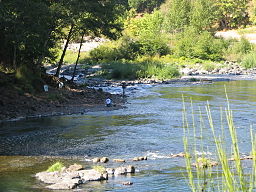Umpqua River
| Umpqua River | |
|
Fishing in the Umpqua River
|
|
| Name origin: A Native American word for the locality of the river, later applied to the tribe as well | |
| Country | United States |
|---|---|
| State | Oregon |
| County | Douglas |
| Source | Confluence of North and South Umpqua Rivers |
| - location | Near Roseburg |
| - elevation | 362 ft (110 m) |
| - coordinates | 43°16′05″N 123°26′46″W / 43.26806°N 123.44611°W |
| Mouth | Pacific Ocean |
| - location | Reedsport |
| - elevation | 0 ft (0 m) |
| - coordinates | 43°40′09″N 124°12′18″W / 43.66917°N 124.20500°WCoordinates: 43°40′09″N 124°12′18″W / 43.66917°N 124.20500°W |
| Length | 111 mi (179 km) |
| Basin | 4,640 sq mi (12,018 km2) |
| Discharge | for near Elkton, 56.9 miles (91.6 km) from the mouth |
| - average | 7,343 cu ft/s (208 m3/s) |
| - max | 265,000 cu ft/s (7,504 m3/s) |
| - min | 663 cu ft/s (19 m3/s) |
|
Map of the Umpqua River watershed
|
|
The Umpqua River (/ˈʌmpkwə/ UMP-kwə) on the Pacific coast of Oregon in the United States is approximately 111 miles (179 km) long. One of the principal rivers of the Oregon Coast and known for bass and shad, the river drains an expansive network of valleys in the mountains west of the Cascade Range and south of the Willamette Valley, from which it is separated by the Calapooya Mountains. From its source northeast of Roseburg, the Umpqua flows northwest through the Oregon Coast Range and empties into the Pacific at Winchester Bay. The river and its tributaries flow entirely within Douglas County, which encompasses most of the watershed of the river from the Cascades to the coast. The "Hundred Valleys of the Umpqua" form the heart of the timber industry of southern Oregon, generally centered on Roseburg.
The Native Americans in the Umpqua's watershed consist of several tribes, such as the Umpqua (a band of the Coquille for which the river is named), and the Kalapuya. These tribes witnessed much of the Great Flood of 1862, during which the Umpqua and other rivers rose to levels so high that even the oldest Indians had never seen a greater flood.
...
Wikipedia


